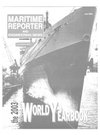
Page 62: of Maritime Reporter Magazine (June 2003)
Read this page in Pdf, Flash or Html5 edition of June 2003 Maritime Reporter Magazine
SSS: Separate Storage Shuttling
The advent of FPSO and Shuttle Tankers serving the deep- water fields of the Gulf of Mexico is drawing closer, as oil companies study the most economical means to move prod- uct from point A to B, particularly from remote and deepwa- ter portions of the Gulf of Mexico.
The GOM region, which has one of the more complex sub- sea piping systems in the world, is ripe for the shuttle tanker solution as the search for oil and gas pushes further from the shore. The question then does not center on "if," but rather "when." American Shuttle Tankers (AST) is touting its S-S-
S, or Separate Storage Shuttling solution. The system is unique in that it works with any floating production system — a key point given the fact that there are zero FPSO proj- ects currently underway — including semisubmersibles, spars and Tension Leg Platforms. The system uses the pro- duction platform, a DPS enabled shuttle tanker alongside, which acts as a storage facility, and a shuttle tanker that is used to transport the production to market. While AST would have to build the transporting shuttles in a U.S. yard to com- ply with Jones Act regulations, it would employ Navion shut- tle tankers as the storage and transfer units, which would not have to comply with Jones Act rules.
Employing DPS enabled shuttle tankers from the North Sea as an FSO in the S-S-S concept is truly a hinge to the project, as it allows the system to be functional much more quickly.
In addition, the DPS capability allows for the elimination of permanent mooring, an estimated $80 to $100 million cost in
A patent-pending concept from American Shuttle Tankers dubbed
Separate Storage Shuttling (S-S-S) envisions a unique shuttle tanker sys- tem for the Gulf of Mexico — serving a variety of floating production sys- tems — that is cost competitive with pipelines. some GOM deepwater regions estimates Peter M. Lovie,
V.P Business Development of AST.
As with many other great innovations, the driver behind
SSS is money, specifically economizing the process of mov- ing oil from production site to refinery. According to Lovie, direct shuttle loading in the Gulf of Mexico, sans FPSOs and taking into account the average production rate of 50,000 bpd for most offshore facilities, is simply cost prohibitive, with an estimated 10-day load period for 565,000 barrel shuttle tanker directly connected to a production source. The SSS solution allows for faster turnaround times for shuttle tankers transporting oil back to port, a turnaround measured in hours instead of days.
E171M 3 [eTti 351 rj 1351 iTl^-f^ LMI
QUALITY MANAGEMENT ISO 9001:2000
The biggest shiprepair and new building complex of South America is also the best shipyard to carry out all kinds of repairs on vessels, floating units and offshore marine equipments.
Our certificate ISO 9001:2000 also qualifies us with excellence as logistic support base to the "OFFSHORE" activities - 1 -"SC "WW-
Lifting capacity 20,000 tons 800 meters of quay with facilities w
New FSPV Vessel
Unveiled
FBM Babcock Marine recently unveiled the FSPV, a vessel under devel- opment for three years that the manufac- turer describes as "a revolutionary new high speed passenger ferry, which prom- ises to deliver pioneering rough condi- tion seakeeping capability, coupled with speeds of up to 40 knots."
FSPV incorporates the SWATH form with waterjets, and is designed to allow speeds of up to 40 knots to be maintained in sea conditions beyond a significant wave height of 3 m (relating to maxi- mum wave heights beyond 5 m). "This vessel is the answer for fast ferry operators who have problems maintain- ing their service schedules due to weath- er conditions, or have exposed routes where reliable high speed services have previously been unfeasible," said John
Warbey, managing director, FBM
Babcock Marine. "Development from
FBM Babcock Marine's proven SWATH technology, with three previous slower vessels in service, the FSPV will provide reliability and continuity of service in high seas with passenger comfort being far superior to that offered by conven- tional multihulls or hydrofoils."
The FSPV offers large deck areas enabling flexible seating layouts for about 400 passengers.
Circle 80 on Reader Service Card
HZ Enters Wind Turbine
Market at Gale Force
Japan's Hitachi Zosen launched full- scale efforts to develop a floating-type offshore wind turbine generation system in preparation for the arrival in the near future of a 10,000 MW offshore wind turbine generation era in Japan. The design, which literally has been on the drawing board for some time, will be bolstered with a series of experiments in 2003. The floating substructure consists of a main floating block and multiple sub-floating blocks, each with a shallow draft. The design facilitates in-dock con- struction. launching, towing and installa- tion of the floating structure.
Circle 88 on Reader Service Card *> Av. Do Contorno, 169 - Barreto - CEP 24110-200 - Niiteroi - RJ Brasil
Phone: (5521) 2628-1025 - Fax: (5521) 2624-1662 / 2628-7855
E-mail: [email protected] Web-site: www.enavi.com.br
Circle 348 on Reader Service Card 62 Maritime Reporter & Engineering News

 61
61

 63
63
